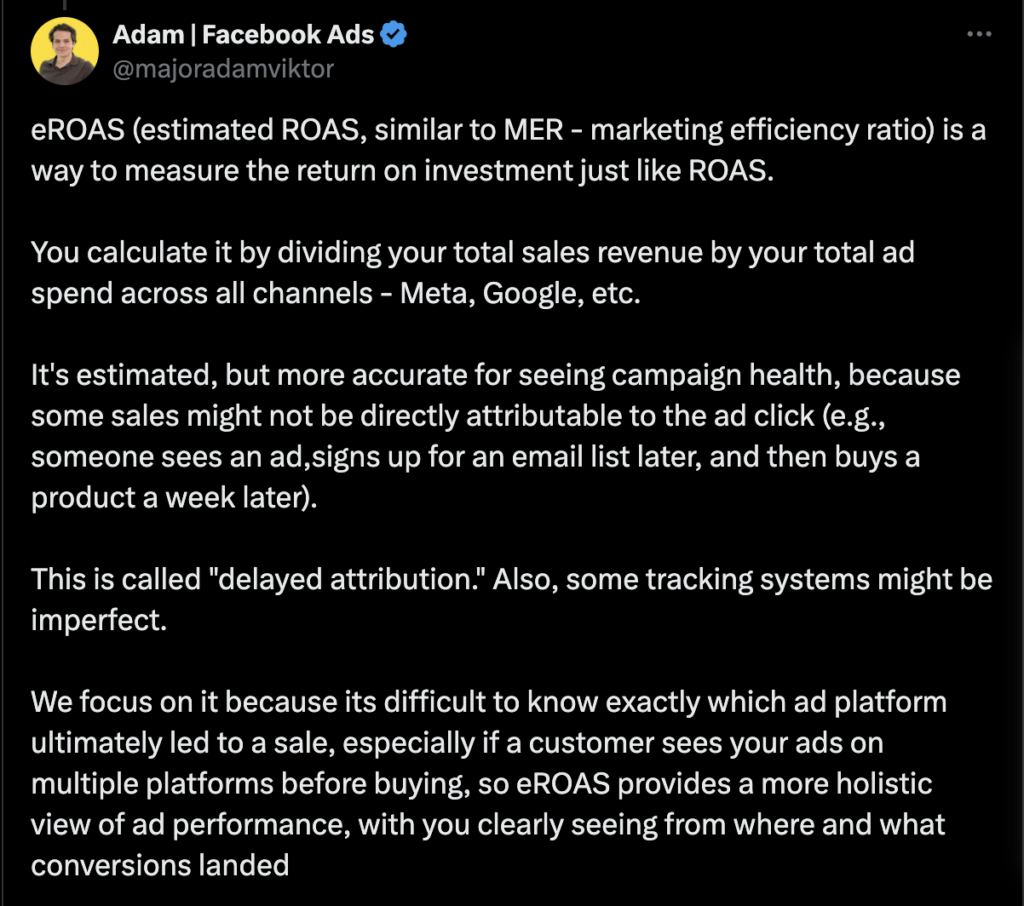ROAS is not the North Star metric you thought it was!
Return on Ad Spend (ROAS) just isn’t good enough as a measure of your marketing efforts—even if you are brand advertising on one platform. In-platform reported ROAS is inherently flawed, misleading and at best only 70% accurate.
ROAS is a marketing performance metric that calculates revenue generated by your ad campaigns. However, it has shortcomings.
- It is channel-specific: ROAS is simply too focused on individual channel reporting, failing to account for the entire customer journey across multiple touchpoints.
- Vanity metrics: ROAS often leads to misleading conclusions if not considered within the broader context of overall marketing performance.
Instead, your brand needs a metric that is able to measure your marketing’s overall impact on real business outcomes; across platforms.
That overall impact is your Marketing Efficiency Ratio (MER)
Simply put, MER is total revenue (for your business) divided by total ad spend for all channels (Facebook, Google, etc.) Essentially, it is the average ROI across all channels.
In this article, we dive deep into why MER is the metric you need to be tracking over ROAS, how to measure and optimise it, and how to use it to win the war of attention in your market.
But first, what is the difference between the two metrics and where and when should they be used?
MER vs. ROAS
ROAS (Return on Ad Spend)
- Purpose: Measures the revenue generated per dollar spent on individual ad campaigns.
- Usage: Best for analysing the performance of specific marketing campaigns or comparing the profitability of different ad initiatives.
MER (Marketing Efficiency Ratio)
- Purpose: Assesses the overall efficiency of all marketing efforts combined across various platforms.
- Usage: Ideal for evaluating the comprehensive efficiency of your entire marketing strategy.
Comparison
Both MER and ROAS are crucial for assessing marketing effectiveness and can be utilised to inform your marketing strategy, evaluate campaigns, and track ROI.
- ROAS: Offers an in-depth understanding of the performance of specific campaigns and creatives.
- MER: Provides a holistic view of overall marketing performance, capturing the efficiency of all combined marketing campaigns.
While ROAS focuses on individual campaign effectiveness, MER delivers a broader perspective on the collective impact of your marketing activities.
In the war for attention, your approach is key!
Whatever the size and shape of your advertising campaigns, it’s important to analyse and measure them well to maximise your ROI.
Whilst there is value in taking a detailed approach to analysing the performance of each creative in your ad campaigns there is greater value in being able to view your ad campaigns as more than standalone creatives.
For instance, there have been cases where we assessed the performance dashboards of multi-channel campaigns and stressed over the 15% week-on-week drop in ROAS for one channel, only to find out that conversions had increased by 45% on another channel and that the overall revenue had grown by 20%. All of which in totality are great results.
ROAS therefore does not facilitate the multi-channel approach that is required to stay ahead of the curve in the marketing paradigm of 2024. While ROAS can tell you how much revenue any specific ad spend is driving, it does not take into account the user journey across all touchpoints that contribute to the final conversions.
Customer journeys are unpredictable and can follow various paths
In no particular order, your customers might…
- See your Meta ad in the wild
- Google your brand
- Google your product
- Compare prices on Amazon
- Visit your website
- Check your socials… then get distracted
- See your ad… AGAIN, with a lot more interest this time
- Visit your website again and add to the cart
- May or may not abandon the cart
- See your ad yet again
- Revisit the website and cart
- Finally, convert
If we look at the customer journey mapped above; we know that customers typically interact with more than one ad campaign and more than one channel before buying into a brand. MER is a metric that takes into account the total value generated by your marketing strategy across all platforms.

The relationship between MER and your attribution model
ROAS can only credit sales to the very last touchpoint, discrediting all the crucial steps that came before. This is especially true now that GA4 only offers two attribution models: last click and data-driven.
This is precisely why e-commerce brands need MER as their main metric, to eliminate the attribution problem by looking at the marketing efforts holistically and not just at standalone platforms.
All marketing teams; SEO, search and social want to claim a sale or lead as their achievement. However, the fact is, that no customer journey is straight or limited to one channel. (see the customer journey map above)
MER eliminates this conflict by focusing on overall efficiency instead of individual attributions. Now it won’t matter which channel or campaign generated a conversion. This way you can attribute the success and/or failure of your marketing campaigns to the overall effectiveness and efficiency of your ads across platforms in driving revenue growth.
By looking at your total marketing spend across ad spend on various channels vs. your total revenue irrespective of your marketing platform; MER cuts through the noise of vanity metrics and channel-specific KPIs to answer the only question that really matters.
How to calculate MER
To calculate your marketing efficiency ratio you need to calculate your cumulative marketing expenses and overall revenue from all your marketing platforms. Some of the most common expense metrics include your total spend on marketing including the cost of services and resources. Revenue metrics can include website traffic and conversions, sales and/or leads generated from your marketing campaigns.

Once you have this data, you can use it to calculate your marketing efficiency ratio as follows:
So for instance, if you spent $10,000 on marketing activities over a given period and generated $25,000 in revenue during that same time period, your marketing efficiency ratio would be 0.4 ($10,000 / $25,000).

Or, if you generated $1,000,000 in revenue on $200,000 in marketing spend last quarter, your MER would be 5.
$1,000,000 / $200,000 = 5
So, how do you use MER to inform your marketing decisions? The key is benchmarking.
Current metrics against your benchmarks
Start by recording your key metrics—MER, nCAC, nMER—during a period when your business is performing well. These metrics will serve as your benchmarks.
As you track performance over time, compare your current metrics against these benchmarks. The goal is to maintain or exceed your benchmarked MER, rather than focusing solely on an arbitrary ROAS figure.
The litmus test to check if your MER is working
Assuming your benchmark MER is 3.5 and your Meta ROAS is 1.23. If your Meta ROAS decreases to 1.1 but your MER remains at 3.5, that’s acceptable!
It likely indicates that your Meta marketing is effectively driving upper-funnel activities, with sales being captured through other channels.
On the other hand, if your Meta ROAS increases to 2.0 but your MER drops to 3.0, it may signal an issue. This could suggest over-investment in lower-funnel activities at the expense of upper-funnel channels that were initially driving your pipeline. Therefore, your MER benchmarks should be aligned with your specific growth goals and unit economics.
To ensure you meet your goals and targets, work backwards from your revenue objectives to set your MER benchmarks accordingly.
Advantages of using MER to inform your marketing strategy
Holistic view: MER takes into account all marketing channels, thus providing a comprehensive picture of marketing and advertising efficiency.
Cost efficiency and resource allocation: MER helps brands optimise their marketing expenses by identifying underperforming marketing channels. This allows a thorough analysis of all marketing costs, helping businesses eliminate unnecessary spending and make informed decisions on resource distribution. These insights provide a direction to where marketing investments should be directed to enhance overall efficiency.
Sustained performance monitoring: MER facilitates long-term evaluation of marketing impact and effectiveness. By tracking this ratio over time, marketers can identify trends, recognise patterns, and make strategic decisions to ensure sustainable growth.
The benefits of using MER as your North Star metric will reflect in the way it informs your marketing strategies, allowing you to make data-driven decisions and improve your ROI.
Strategies you can implement to optimise MER
To enhance your brand’s marketing efficiency ratio and maximise ROI for your e-commerce brand, consider the following strategies:
- Dynamic creative optimisation (DCO)
- Use Dynamic Creative Optimisation to automate the testing of various ad elements such as images, headlines, and CTAs. This allows you to identify the most effective combinations in real time. Tools like Google Ads’ responsive search ads or Meta’s dynamic creative ads can help you implement DCO effectively.
- Example: Regularly update and rotate ad creatives based on performance data to keep your campaigns fresh and engaging. This can lead to higher engagement rates and conversion metrics.
- Advanced segmentation and personalisation
- Implement advanced segmentation strategies to target different customer segments with personalised marketing messages. Use customer data to create detailed buyer personas and tailor your ads accordingly.
- Example: Segment your email list based on purchase history, browsing behaviour, and demographic information. Send personalised product recommendations and special offers to each segment to increase relevance and engagement.
- Conversion rate optimisation (CRO) techniques
- Focus on CRO techniques to improve the performance of your landing pages. Conduct A/B testing on headlines, images, CTAs, and form lengths to determine what converts best. Use heatmaps and user session recordings to identify pain points and areas for improvement.
- Example: Test different value propositions and CTAs on your product pages. Use tools like Hotjar or Microsoft Clarity to gather insights and make data-driven decisions to enhance user experience and increase conversion rates.
- Implementing retargeting campaigns
- Use retargeting campaigns to re-engage users who have interacted with your brand but haven’t converted. Tailor your retargeting ads based on user behaviour and stage in the buying journey.
- Example: Create a series of retargeting ads that show different product benefits or customer testimonials to users who abandoned their shopping carts. This can help nudge them towards completing their purchase.
In the new era of e-commerce marketing, it is important to identify the right time and opportunity to focus on the right metric and understand when it is optimal to focus on each to ensure long-term success.
Share
Where’s next for your brand?
No matter where you are in your marketing journey, our dazzling team of specialists will keep you moving, show you how to grow, and help you actualise the vision you’ve always secretly had for your brand.









